
- Homepage
- Blade Edge
- Blade Material
- 1095 Carbon Steel (7)
- 20cv (6)
- Bohler M390 (5)
- Carbon Steel (732)
- Cpm-20cv (11)
- Cpm-s35vn (9)
- D2 Steel (6)
- Damascus (17)
- Damascus Steel (190)
- Elmax (9)
- Elmax Steel (5)
- Folded Carbon Steel (6)
- Folded Steel (34)
- High Carbon Steel (14)
- M390 (26)
- S35vn (19)
- S90v (7)
- Stainless Steel (462)
- Steel (8)
- Zdp-189 (5)
- Other (789)
- Blade Range
- Blade Type
- 0452cf (4)
- Cleaver (5)
- Clip Point (238)
- Dagger (7)
- Drop Point (334)
- Drop Point, Tanto (4)
- Harpoon (7)
- Hawkbill (17)
- Karambit (20)
- Leaf (13)
- Pen (6)
- Reverse Tanto (6)
- Sheepsfoot (29)
- Spear Point (78)
- Straight Back (8)
- Tanto (66)
- Trailing Point (10)
- Upswept (7)
- Upswept Skinner (3)
- Wharncliffe (74)
- Other (1431)
- Dexterity
- Type
T10 Carbon Steel Clay Tempered Bare Blade Folded 15 Times For Jp Samurai Katana
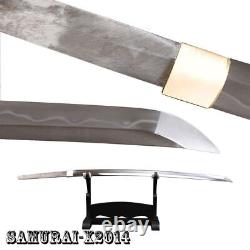
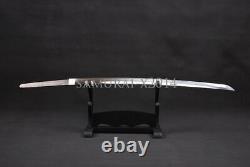
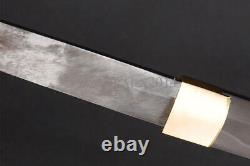
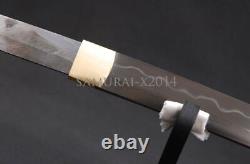
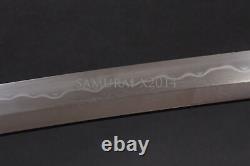
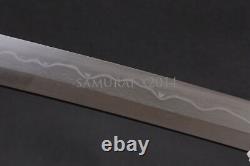
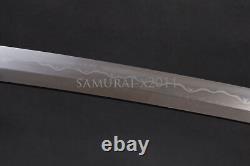

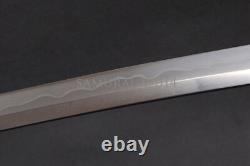
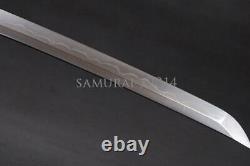


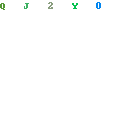
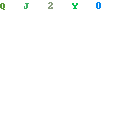
T10 Carbon Steel Clay Tempered Bare Blade Folded 15 Times For Jp Samurai Katana. Hamon: Real clay tempered hamon. 13 times hand forged and polished. Please allow 1-2cm differs due to manual measurement, thanks. Now we add a free brass habaki for this blade.
The data cannot be exactly same as we offer. There is no hole on the nakago/tang of the blade, you need drill it by yourself. Usually we don't maintain the nakago part.
BLADE: The blade has been hand forged using the ancient method of sword making. Full hand forged, hand polished and hand sharpened. This blade has been hand polished with multiple grade sharpen stone by Japanese method, which made the surface of the blade like a mirror, the blade is also very sharp. This blade comes with a full length Tang which greatly enhances the strength of the sword.This blade is strong enough to cut through a thick bamboo tree. HOW TO TREAT THE BLADE? Japanese blade is made from the pure steel, and is completely polished. So, suitable treatment is necessary. Because the surface is delicate and the cutting edge is very sharp.
The blade should be always coated with good oil. And we never touch the blade with naked finger. Please do not put the blade on a carpet.
Please put it on a clean table cloth and use some soft cloth or paper as a pillow for the blade. Careless treatment makes scratches onto the blade surface.
HOW TO DISASSEMBLE A JP SWORD. For engraving English words, Chinese characters and Japanese Kanji. For engraving patterns dragon, lion, etc. Swords can be shaped by a variety of metalworking techniques. The primary techniques are forging and stock removal.
Forging uses heat to bring the material to a malleable state. The material is then hammered to shape, typically using hammer and anvil together with specialized set and fuller tools depending on the particular technique.Stock removal shapes the sword from prepared stock that is larger in all dimensions than the finished sword by filing, grinding and cutting. After the blade has been shaped, the sword would be quenched. We quench our swords in either water or oil.
Water quenching produces a tougher edge which can also be hardened further more using clay. Blades quenched in oil are still considerably hardened and do have superior flexibility compared to a water quenched blade.
The more rapidly a blade cools down, the harder it becomes. Thus, when a hot blade enters the water, the water also gains heat and the blade will cool more gradually. Therefore, the first part of the blade that enters the water will be the hardest. Therefore, the technique of quenching was also very important. If a blade has any flaws from forging (air bubbles, ash), it will break immediately during the quenching process.
After quenching, the sword will be quite tough and brittle, with little flexibility. To overcome this, the blade would undergo a tempering process. The blade would be reheated to a certain temperature degree then allowed to cool naturally.
The blade would be slightly less tough afterward but have a greater degree of flexibility - the art would be to perfectly balance the blade for toughness, sharpness and flexibility. Finishing encompasses polishing, decorating, and crafting and assembling the hilt, guard and sheath. The swordsmith would be most concerned with the state of the blade itself and possibly decorating the blade and preparing the guards and pommel. Other artisans would likely be involved in the work of fashioning the hilt, sheath and other furniture; and in any fine decoration. When the rough blade is completed, the swordsmith turns the blade over to a polisher, whose job it is to refine the shape of a blade and improve its aesthetic value.
The polishing process almost always takes longer than even crafting, and a good polish can greatly improve the beauty of a blade, while a bad one can ruin the best of blades. Early polishers used three types of stone, whereas a modern polisher generally uses seven. On high quality blades, only the back of the blade and the adjacent sides, are polished to a mirror-like surface. To bring out the grain and hamon, the center portion of the blade, and the edge are usually given a matte finish. Microscopic scratches in the surface vary, depending on hardness.
Smaller but more numerous scratches in the harder areas reflect light differently from the deeper, longer scratches in the softer areas. The harder metal appears more matte than the softer, and the manner in which it scatters light is less affected by the direction of the lighting. After the blade is finished it is passed on to a mountings-maker for fashioning the hilt, sheath and other mountings. International Buyers - Please Note.This item is in the category "Collectibles\Knives, Swords & Blades\Blade Parts, Supplies & Accs\Blade Parts & Supplies". The seller is "wangyanfang2016-1" and is located in this country: CN. This item can be shipped worldwide.
- Country/Region of Manufacture: China
- Type: Katana, Blade
- Edge: Single, Curved
- Tang: Full
- Handedness: Double-Handed
- Blade Material: Damascus Steel
- Dexterity: Ambidextrous
- Theme: Samurai
- Brand: SJ SHI JIAN
- Original/Reproduction: Original

